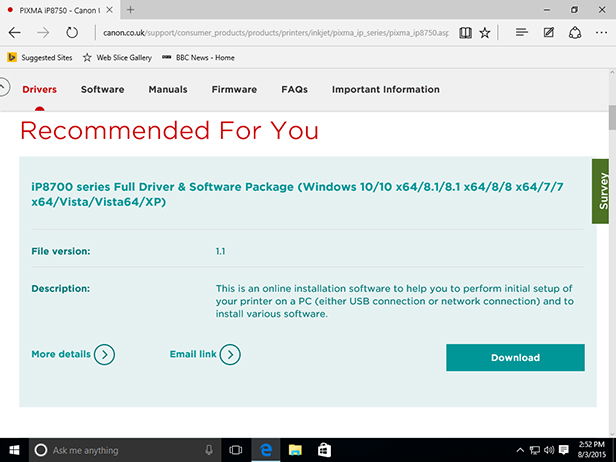Drivers Needed For Windows 10 Install Failed


When attempting to install a driver in Windows 10 the installation fails. On your first boot of a fresh installation of Windows 10, Windows Update will attempt to download and install GPU drivers in the background. This can sometimes take up to 5-10 minutes before the silent driver installation will begin. If you attempt to manually install a driver during this time, it will fail immediately, because a driver install is already being done silently in the background. Once the silent driver install is completed, you will need to reboot your PC for it to finalize.
For more info, see Free up drive space in Windows 10 . Bre Soakaway Software. Run Windows Update a few times. Download and install any available updates in Windows Update, including software updates, hardware updates, and some third-party drivers. Use the troubleshooter for Windows 10 to fix Windows Update errors. Check third-party drivers and download any updates. Troubleshoot Windows 10 Installation. When the file needed by Windows 10 is missing. Pops up on your screen whenever your Windows 10 upgrade failed.
In order to get a driver installed outside of Windows Update do the following: -On a fresh install or update and first boot of Windows 10, let Windows sit for at least 15 minutes to ensure the background silent download and installation is completed. -Reboot your PC to finalize the installation. -Check to see the correct drivers are installed and functional, check to see if the NVIDIA Control panel is available. -If there is still no driver installed, download the latest driver from our website and begin a manual installation.
-During the installation Select 'Custom' and check the box for 'perform clean installation'. Download Webstorm 10 Full Crack Internet.
Computer Type: PC/Desktop System Manufacturer/Model Number: Custom build by me OS: Windows 10 Pro CPU: Core i7-6900K Motherboard: ASUS X99-Deluxe II Memory: 32GB Crucial RAM Graphics Card: Nvidia Gforce GTX 750 Ti Monitor(s) Displays: 2x Dell U2413 Screen Resolution: 1920 x 1200 Keyboard: Das Keyboard Pro (Cherry MX blue w/O-Ring Mod) Mouse: Logitech MX-610 Laser w/Teflon pads PSU: Corsair_AX750 Case: Lian Li PC-B10 Cooling: Nochua NH-D14 Hard Drives: Samsung 960pro M. Hp Elitebook 8470p Bluetooth Driver Windows 8. 2 512GB SSD Samsung 850pro 256GB SSD WD600GLFS Antivirus: Windows Defender. Computer Type: PC/Desktop System Manufacturer/Model Number: Custom build by me OS: Windows 10 Pro CPU: Core i7-6900K Motherboard: ASUS X99-Deluxe II Memory: 32GB Crucial RAM Graphics Card: Nvidia Gforce GTX 750 Ti Monitor(s) Displays: 2x Dell U2413 Screen Resolution: 1920 x 1200 Keyboard: Das Keyboard Pro (Cherry MX blue w/O-Ring Mod) Mouse: Logitech MX-610 Laser w/Teflon pads PSU: Corsair_AX750 Case: Lian Li PC-B10 Cooling: Nochua NH-D14 Hard Drives: Samsung 960pro M.2 512GB SSD Samsung 850pro 256GB SSD WD600GLFS Antivirus: Windows Defender.
There can be some features of your motherboard that can be enabled with the manufacturer's chipset driver that may not be enabled with a generic Windows driver. If Windows has installed the manufacturer's driver already then this may not be necessary. You can check to see which driver you have by going to Device Manager >System Devices >select any of the devices that say Chipset >Right Click on it >Properties >Driver, and see if it is a Microsoft or an Intel driver (or AMD if you were checking an AMD board). Computer Type: PC/Desktop System Manufacturer/Model Number: Self Built OS: W10 Home 1709 CPU: i7-3820 Sandy Bridge-E Motherboard: Asus P9X70 Pro Memory: 16 GB DDR3 Graphics Card: GeForce GTX660 Sound Card: On Board - Realtek Monitor(s) Displays: Acer S271HL Screen Resolution: 1920 x 1080 Keyboard: MS KC0405 Mouse: Logitech / MS Mobile Mouse 3500 PSU: Corsair 850TXV2 Case: Corsair Obsidian Series 550D Cooling: Cooler Master Hyper 212 EVO Hard Drives: Samsung 840 Pro Series 128GB WD Black - 1TB (2) Internet Speed: 200 Gb/s Browser: Firefox Antivirus: Avast!